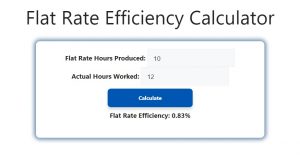About Flat Rate Efficiency Calculator (Formula)
In industries where flat-rate billing is common, understanding efficiency is crucial for optimizing productivity and profitability. The Flat Rate Efficiency Calculator helps businesses determine how effectively time is being utilized in producing work against the hours logged. This metric is essential for evaluating employee performance and identifying areas for improvement. In this article, we will explore the formula used for calculating flat rate efficiency, explain how to use the calculator, provide a practical example, and address common questions related to flat rate efficiency.
Formula
The formula for calculating Flat Rate Efficiency (Efr) is:
Flat Rate Efficiency (Efr) = Flat Rate Hours Produced / Actual Hours Worked
This formula helps gauge how much work was produced relative to the actual hours spent working.
How to Use
Using the Flat Rate Efficiency Calculator is straightforward. Follow these steps:
- Determine Flat Rate Hours Produced: Calculate the total flat rate hours generated from the completed work. This represents the expected time for the task based on flat-rate billing.
- Identify Actual Hours Worked: Record the total hours that employees actually worked on the tasks, including any additional time spent beyond the flat-rate estimate.
- Input Values: Enter the values for Flat Rate Hours Produced and Actual Hours Worked into the calculator.
- Calculate Efficiency: The calculator will compute the Flat Rate Efficiency using the formula, providing a clear percentage of efficiency.
- Analyze Results: Review the output to assess productivity and determine if adjustments are needed to improve efficiency.
Example
Let’s say a mechanic completed a job that has a flat rate of 10 hours. However, they took 12 hours to finish the work. To calculate the Flat Rate Efficiency:
Flat Rate Efficiency (Efr) = Flat Rate Hours Produced / Actual Hours Worked
Flat Rate Efficiency (Efr) = 10 hours / 12 hours
Flat Rate Efficiency (Efr) = 0.833 or 83.3%
In this example, the flat rate efficiency is 83.3%, indicating that the mechanic produced 83.3% of the expected output relative to the hours worked.

FAQs
- What is flat rate efficiency?
Flat rate efficiency measures how effectively time is utilized in completing tasks compared to the time expected under a flat rate billing system. - Why is flat rate efficiency important?
It helps businesses assess productivity, identify performance gaps, and optimize work processes for better profitability. - How is flat rate efficiency calculated?
It is calculated by dividing the flat rate hours produced by the actual hours worked. - What does a flat rate efficiency below 100% indicate?
It suggests that more time was spent on a task than expected, signaling potential inefficiencies. - Can flat rate efficiency be improved?
Yes, through better training, process optimization, and resource management. - What industries commonly use flat rate billing?
Industries like automotive repair, plumbing, and HVAC services frequently use flat rate billing. - What factors can affect flat rate efficiency?
Employee skill level, complexity of the job, and availability of tools and resources can all impact efficiency. - How often should flat rate efficiency be assessed?
Regular assessments, ideally after every project or periodically, help maintain productivity standards. - What is a good flat rate efficiency percentage?
A flat rate efficiency of 90% or higher is generally considered good, though this may vary by industry. - Can external factors impact flat rate efficiency?
Yes, factors like supply chain delays, equipment failures, and unexpected challenges can affect efficiency. - How can managers use flat rate efficiency data?
Managers can use the data to provide feedback, identify training needs, and set realistic performance goals. - What is the difference between flat rate and actual hours?
Flat rate hours are the estimated hours for completing a job, while actual hours are the real time spent on the task. - How do I calculate efficiency if I have multiple jobs?
Calculate the total flat rate hours produced and total actual hours worked for all jobs, then use the formula. - What should I do if my efficiency is consistently low?
Investigate potential causes such as inadequate training, inefficient processes, or insufficient resources. - Is there software available to track flat rate efficiency?
Yes, many project management and time-tracking software options can help monitor efficiency metrics. - How can I motivate employees to improve their efficiency?
Incentives, recognition programs, and targeted training can encourage employees to enhance their performance. - What is a benchmark for flat rate efficiency?
Establishing internal benchmarks based on historical data can help evaluate current performance. - How do I communicate efficiency results to my team?
Share data in team meetings, provide context on performance, and discuss improvement strategies collaboratively. - Can flat rate efficiency affect pricing strategies?
Yes, understanding efficiency can inform pricing decisions and help ensure profitability. - What role does customer satisfaction play in flat rate efficiency?
High efficiency can lead to quicker service delivery, which often results in increased customer satisfaction.
Conclusion
The Flat Rate Efficiency Calculator is an essential tool for businesses utilizing flat-rate billing. By understanding the formula and following the steps outlined in this article, users can effectively measure and improve efficiency. With this knowledge, businesses can enhance productivity, optimize operations, and ultimately boost profitability. Regular assessment and adjustment based on efficiency metrics will lead to sustained success in flat-rate environments.
